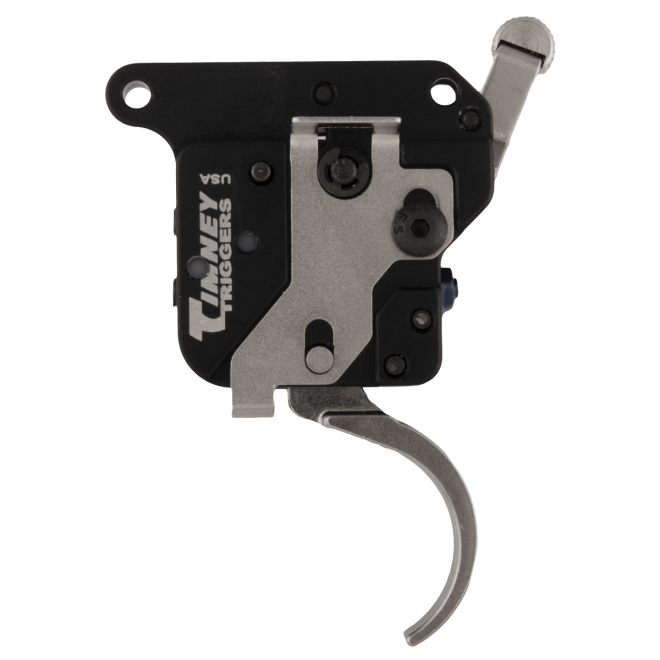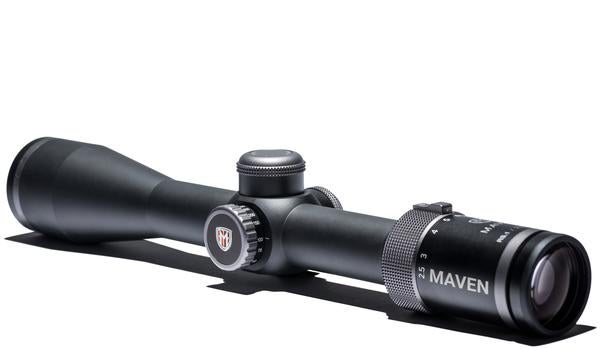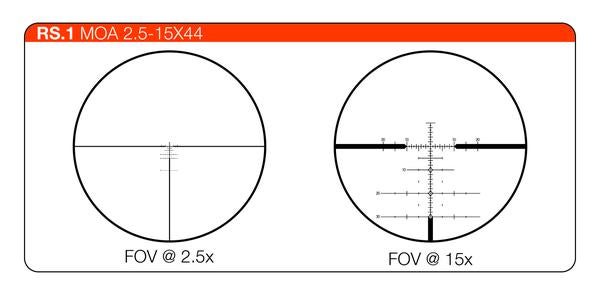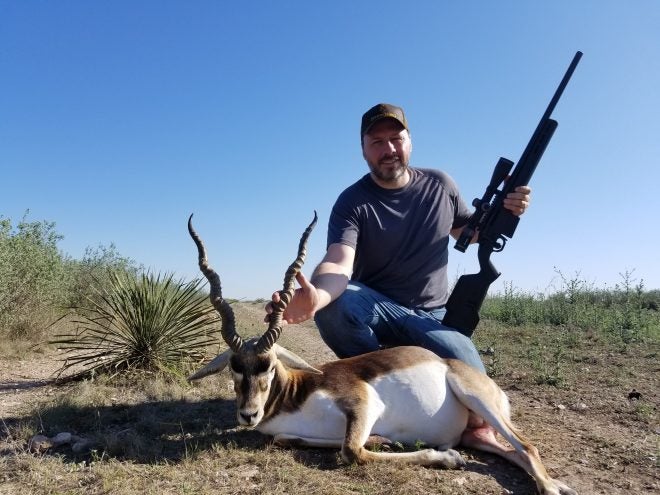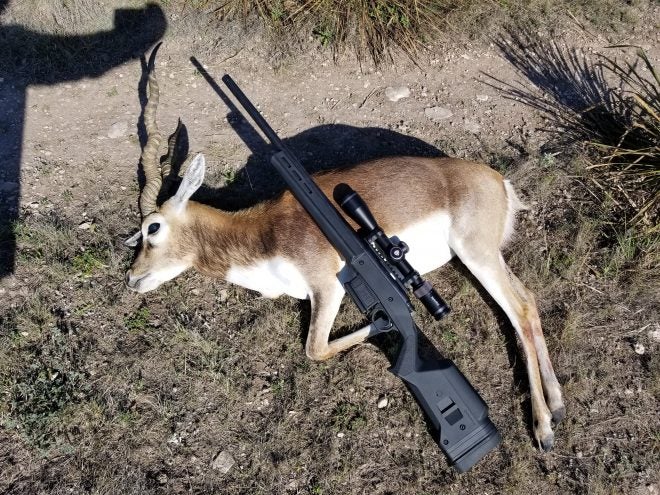Hunt After-Action Report: a Timney Trigger, Maven RS1 Scope, & a Trophy Blackbuck
Jon Stokes 05.28.18
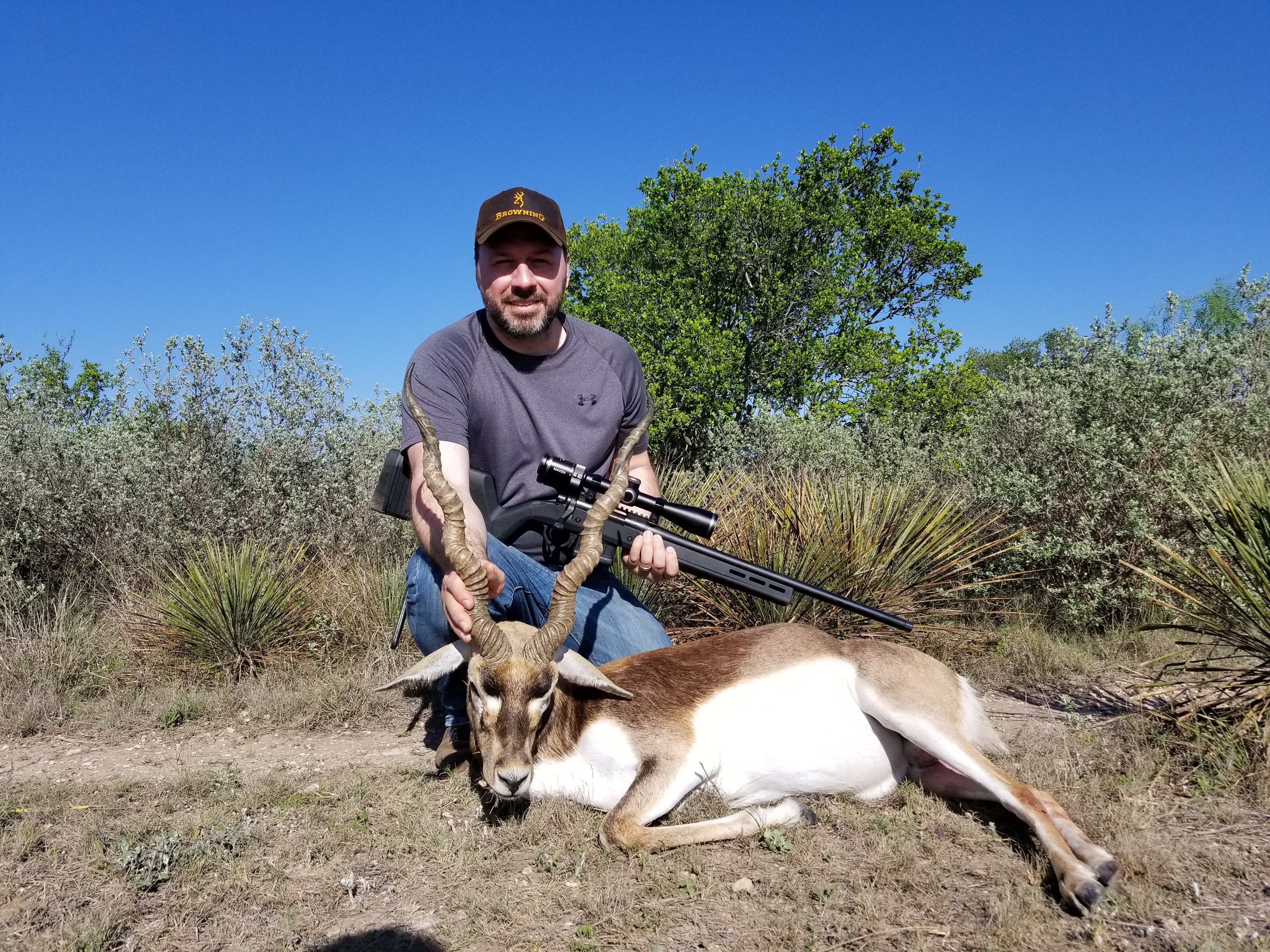
A few weeks ago, I got the chance to go on a hunt at a ranch operated by TC Outfitters in South Texas, not far from Del Rio and the border. There were turkeys, black buck, axis, hogs, and other assorted game, but I was really there to score my first blackbuck.
The photo above spoils the punchline. I got a beauty of a blackbuck, and my gear performed really well. Here’s the story of the hunt.
Rifle Upgrade #1: Timney trigger
I’ve been hunting this season with the Remington 700 Magpul Edition in 6.5 Creedmoor, and have written quite a bit about how much I like this gun.
The X-Mark Pro trigger is quite good: a crisp, consistent, single-stage pull. But Timney got in touch and asked if I wanted to try out their drop-in, so I went ahead and got one of their Remington 700 drop-in trigger kits.
After a really easy install, I had an adjustable trigger that was a small but noticeable upgrade over the X-Mark. The Timney feels lighter, with a bit less creep. The break is about the same, and overall the Timney kit has fewer parts and is easier to get in and out of the gun.
Rifle Upgrade #2: Maven RS.1 Scope
The next upgrade to the rifle was a good scope. I run a Leupold Mk 8 CQBSS with the Horus reticle on my AR-10, and it’s dialed in so I wasn’t eager to pull it off and re-zero it for 6.5 Creedmoor gun. Luckily, a new(ish) direct mail optics company, Maven, got in touch and sent along their first rifle scope.
If you’ve heard of TRACT, Maven is similar in that they’ve produced a line of really well-regarded binoculars that they sell direct to the consumer. (Unlike TRACT, though, Maven also makes spotting scopes, and they sent one of those, too.) Cutting out the retail middleman allows these companies to offer premium optics at incredibly low prices.
The RS1 that I got retails for $1,200 directly from the maker, and in terms of features and performance it goes up against scopes in the $2,000 range.
I’m a huge fan of Horus reticles. Some folks think they’re too busy, but I like the features. So I picked the MOA reticle version of the RS1, which you can see below, because it’s the most Horus-like.
I picked up a steel TPS 1-Piece XP Picatinny 20 MOA rail to mount the scope, and paired it with some 30mm Warne Mountain Tech Scope Rings from Bass Pro.
I set up a steel target with a fresh coat of paint at 100 yards, and ranged it with a Leupold laser rangefinder. I don’t have a bench, so I used some Caldwell bags in a prone position.
For sighting in, I used the rounds I’d be using on the hunt–the same Remington 6.5 Creedmoor HTP Copper rounds I had left over from a previous hunt. After a quick parallax adjustment, I went to work.
Lucky for me, the first shot was actually on the steel and not too far off. It was right at 10 MOA to the right and 5 MOA high, which was easy to call with this reticle. Given that the turrets are 0.25 MOA per click, I was able to do the math and do a two-shot zero.
The turret clicks were positive and easy to discern, which made it that much easier to zero.
Things got interesting when I put a third shot down-range. I heard the steel ring and saw it move, but there were only two shots on it. It looked like a total miss. I jumped up and looked in the spotting scope, and with that I could see what had happened. The third shot was almost on top of the second. Nice!
I sent a few more rounds downrange, and since I was going for minute-of-deer I wasn’t too concerned that my group widened out a bit after that. The other shots weren’t on top of each other like shots two and three, but they were very close. The rifle was dialed in enough to hunt with.
(Look for a more extensive review of the RS1 and the S1A spotting scope, soon.)
The Hunt
The morning of the hunt, the guide dropped me off in the stand in Texas hill country, where I waited on some game to show up.
It was shooter’s choice–hogs, predators, axis, blackbuck, or whatever–and we were still on the tail end of turkey season. Here in Texas, you can shoot turkeys with a rifle at the end of the season, so they were on the menu if I saw one.
The morning was mostly uneventful, and as the sun moved higher in the sky I got bored, and well, I’m gonna admit that I checked my email. I started to fire off a quick reply to someone, when I glanced up and saw an absolute beauty of a blackbuck approaching the stand from afar.
Unlike some of the more oblivious game I’ve hunted on these Texas ranches (and I use the term “hunted” very loosely, because it’s more like “harvesting” or “shooting” when you’re on one of these managed ranches), this blackbuck knew I was in that stand and was nervous about it.
He picked his way toward me slowly across the clearing, walking right along the edge of the brush. His ears and tail were twitching a bit as he stared right at me. I pulled out the rangefinder and ranged him out at 360 yards — farther than I wanted to shoot, so I let him keep coming.
After a few more minutes, I ranged him at 260, and I had a feeling that any moment he was going to cut left and disappear from the clearing into the bush. I had better take the shot, soon.
He approached about 20 more yards, and looked left. I put the crosshairs right over his right shoulder, and pulled the trigger. The animal dropped immediately, and moved a bit on the ground. He laid there just long enough for me to get exited and pull my face off the gun, at which point he jumped back up and limped into the bush and out of sight.
It was at that point that I did something kinda stupid. I went ahead and quickly finished the email I’d been writing before I shot him. After hitting “send,” I looked back up and realized that much of the terrain looked the same, and that I should have ranged the spot where he dropped immediately after he got up, because now finding it was going to be a pain.
To make a long story short, the guide showed up and we never saw a blood trail, but we did find him bedded down about 100 yards away from where I shot him. After finishing him off, we noticed that the round had blown a big hole in his right shoulder, a little bit high of where I had intended to aim. It almost looked like an exit wound–super strange. I’ve never seen that round do that, before.
After some pictures, we got him loaded up, and I went back to the stand. I wasn’t in the stand long when a group of five Toms came along at about 120 yards. I put the scope on them, and then realized that two of them were walking towards each other and were going to pass each other perpendicular to me. It was the perfect setup for another double!
I tracked one of the birds with the scope, waited until they crossed, and pulled the trigger. It was a complete miss, as they all took flight and I sat there wondering what had gone wrong.
I inspected the rifle, and everything seemed to be in order. Nothing had come loose, so I was left at a loss as to how I missed this easy shot with this gun. Then it occurred to me to check the thread protector. It had worked itself completely loose and was wobbling around. So I’m gonna go ahead and blame that thread protector for the miss on the turkeys.
In all, it was a fun, short hunt, and I got to try out some new gear. I also got a great-looking trophy (a European mount on driftwood, which is ready but I haven’t picked it up), a beautiful hide, and some seriously good meat. (As I write this, I just fried the backstrap and cooked some of the ground, and it’s great.)
These are some solid upgrades to an already great rifle. Now if I could just figure out a way to make it lose a few pounds.
Update: Ask and you shall receive. Apparently Maven has recently announced the new RS2, which is only 12.4oz and $550. It doesn’t look to be first focal plane like the RS1, though, which is the only downside, but that’s also why it’s cheaper.
